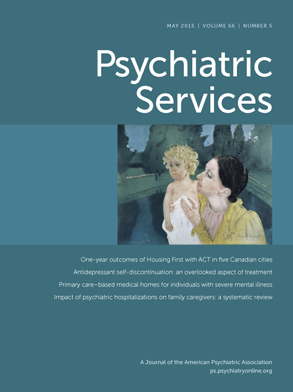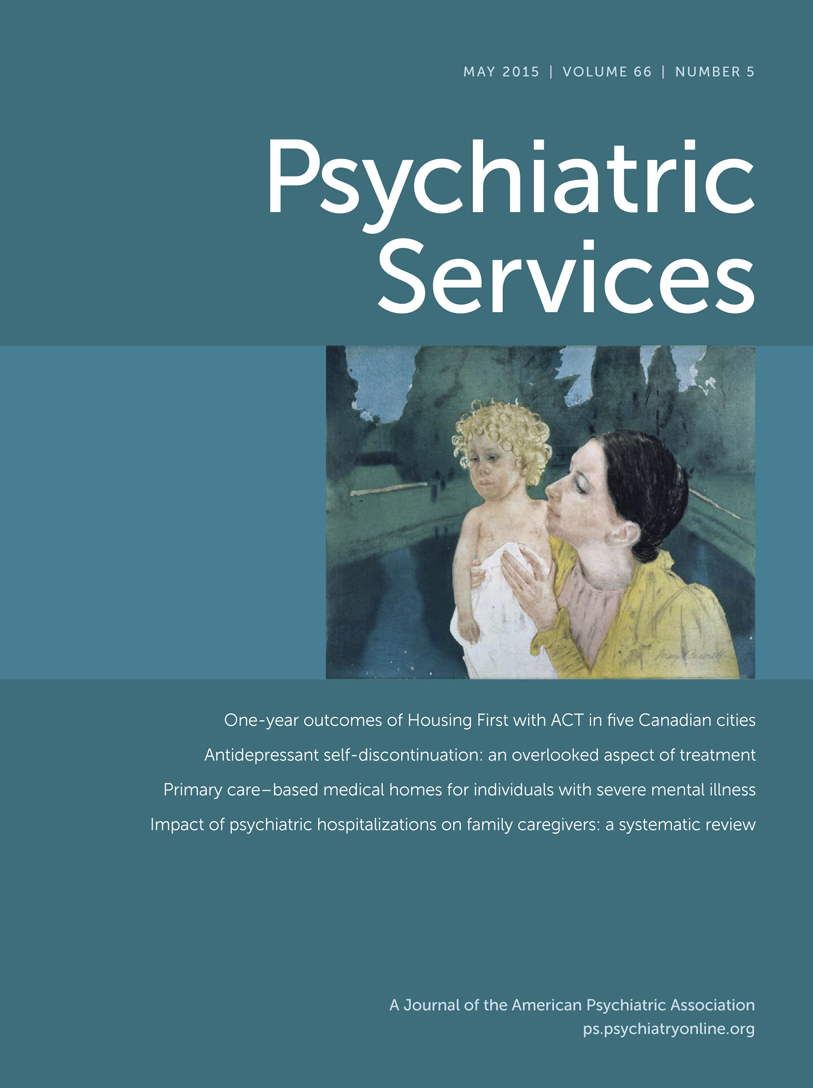Driving a motor vehicle enables people to more easily participate in a range of occupations, including visiting family and friends, shopping, and attending employment (
1). However, it is a complex skill that requires the repeated coordination of a range of body systems (
2). Previous research indicated that people with mental illness are at increased risk of having accidents (
3) and may also be subject to restrictions on, or loss of, their license (
2). Although the regulations governing driving differ among various jurisdictions and nations, providers of psychiatric services have a role to play in supporting safe driving practices among consumers of mental health services.
Driving and Mental Illness
Several studies have found that people with mental illness may be at greater risk of involvement in vehicular accidents, because of both their psychiatric illness and other comorbidities (such as general medical conditions and substance abuse) (
2,
3). People with substance use disorders have an elevated risk of death by vehicular accident (
4), and “hidden” suicides are thought to account for between 1% and 7% of road fatalities (
5). However, little evidence is available about the proportion of mental health consumers who drive and the ways in which they use vehicles to support participation in daily life and recovery. Both a Canadian survey and an Australian service audit found that between 30% and 40% of consumers of mental health services drive regularly (
6,
7). However, driving-related advice is not routinely provided to consumers (
8). A retrospective audit of case notes and discharge summaries found that many psychiatrists were not aware of driving guidelines for consumers of mental health services nor did they discuss them with their patients (
9). Nonetheless, providers of psychiatric services must be aware of the risks of driving among persons with mental illnesses and should implement a range of interventions to mitigate the impact of these risks (
10).
Existing Guidelines and Frameworks
A number of existing guidelines and frameworks are related to safe driving practices for people with mental illness. Many of these are targeted at general medical staff, who often have legal responsibilities for certifying fitness to drive. For example, the Canadian Medical Association has published a driver guide that focuses on determining medical fitness to operate a motor vehicle (
11). Other guidelines incorporate clinical management strategies for use by other health professions, such as Austroads’
Assessing Fitness to Drive (
2).
In some countries—including Australia, Canada, and the United Kingdom—occupational therapists with additional training have a specialized role in supporting safe driving practices among consumers of mental health services. The aims of this role include assessing the functional impact of health conditions on the consumer’s ability to drive; prescribing, monitoring, and evaluating rehabilitation strategies; and serving as liaison to medical practitioners and licensing authorities that provide assessments and interventions for consumers of mental health services (
12). A recent Canadian study found that occupational therapy was perceived as the primary discipline for evaluating driving skills among consumers of mental health services, although further research and development are required to support the role of occupational therapists in supporting driving (
13).
The emphasis on fitness to drive can, however, introduce a dichotomous dimension, which focuses on whether or not consumers are fit to drive. In reality, ability to drive can fluctuate over time, and a change in fitness to drive may not come to the attention of providers of psychiatric services if a consumer’s relapse is rapid or if the consumer avoids engagement. Therefore, there was a need for driving-related guidelines that focus on promoting recovery and consumer self-knowledge and also provide a framework for revisiting driving throughout a consumer’s journey of care.
Development of Driving, Mental Health and You: Guidelines
Driving, Mental Health and You: Guidelines was developed by NorthWestern Mental Health (NWMH), one of the largest publicly funded psychiatric services in Victoria, Australia. NWMH provides a diverse range of care, including crisis assessment, acute treatment, rehabilitation, and continuing care services. The guidelines were initially developed by the NWMH Driving Committee and Occupational Therapy Leadership Group in 2009. Their initial development and the process of providing ongoing updates and new editions have been informed by updated medical standards, research, and extensive consultation with a range of stakeholders from within, and external to, NWMH. The stakeholder groups have included psychiatrists, clinicians, consumer consultants, carer consultants (people who have cared for or supported a consumer and draw upon those experiences to inform systemic change), managers, a pharmacist, a forensic mental health consultant, occupational therapists who serve as driver assessors, and VicRoads (Victoria’s driving regulatory body).
As part of the development of these guidelines, a scoping project was conducted in 2005 to explore clinicians’ awareness of driving issues among consumers of mental health services (
7). Many consumers were found to have a driver’s license and to drive, to want to resume driving, or to be working on obtaining their license; however, consumer driving was not routinely considered in clinical practice at key times in a consumer’s episode of care. When driving issues did arise, there were no guidelines to support mental health professionals’ decision making.
The overall objective of Driving, Mental Health and You: Guidelines was to provide information to providers of psychiatric services about mental illness and driving. To achieve this, the guidelines aim to provide information in the following areas: education for consumers, family, and caregivers about the responsibilities of drivers; key times when mental illness, treatment, or side effects can compromise driving skills; assistance for mental health professionals who are providing support to consumers in gaining or maintaining a driver’s license; guidance for screening consumers to identify and respond appropriately to at-risk drivers and persons who are not fit to drive; indicators that driving ability should be assessed by an occupational therapist; and sources of advice and support regarding complex clinical scenarios.
The complete guidelines are divided into 21 parts so mental health professionals can easily access information during the consumer’s continuum of care, including entry to the service and the acute, subacute, rehabilitation, transition, and exit phases. Although the guidelines are mainly targeted at adolescents and adults with a mental illness, they may also be broadly relevant to consumers experiencing driving-related issues associated with cognitive impairment. The role of various professions is outlined, although much of this information is specific to the local jurisdiction (Victoria). [A copy of the guidelines, excluding information specific to Victoria, is available in an online supplement to this article.]
Conclusions
These guidelines present principled information to assist providers of psychiatric services to support safe driving practices among consumers and are an important initiative for facilitating complex decision making. Guidelines can be integrated and embedded into the existing clinical and risk assessment processes of any psychiatric service and could also be used as a basis for audit and quality improvement activities over time.
These guidelines have now been in regular use within NWMH for the past five years and have been reviewed and evaluated on several occasions. They were recently the subject of a national award for achievement in education, training, and workforce development. A formal evaluation of their impact on practice is currently being planned and will be undertaken in the next 12 months.

